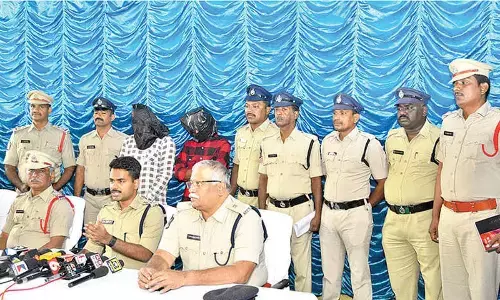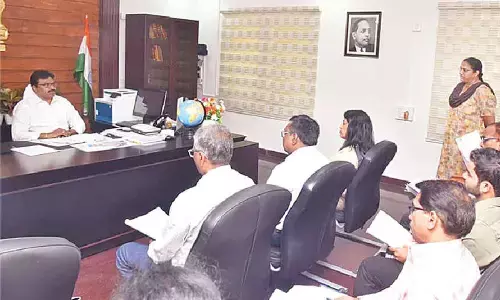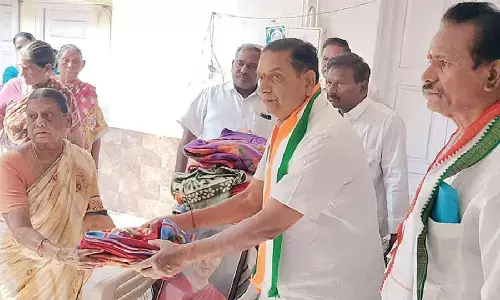Celebrating Legacy and Independence

The 100th birth anniversary of Dr PSR Appa Rao, the modern-day Bharatamuni, and India’s Independence Day were marked by a captivating Kuchipudi recital at Telugu University. Senior disciples of Padmashri Dr Sobha Naidu, Hymavathi Voleti, and Sanjana Siripurapu, brought to life a series of traditional performances that celebrated India’s rich cultural heritage and divine tales
Both the completion of the 100th birth anniversary of the legendary Dr. PSR Appa Rao, revered as the modern-day Bharatamuni, and Independence Day were celebrated with a Kuchipudi recital by Hymavathi Voleti and Sanjana Siripurapu at Telugu University. They are senior students of Padmashri Dr. Sobha Naidu.
The first solo performance by Hymavathi in fetching pink aharya was “Jaya Jaya Priya Bharata,” a patriotic song composed by the illustrious Devulapalli Krishna Sastry. This piece is a tribute to Bharata Mata, celebrating her rich heritage, diverse culture, and the spirit of unity in diversity. It was immersed in rhythm and melody that evoked the pride of being Indian, containing rich stances.
Next was “Kolluvai Unaade Devadevudu” by both dancers, with Sanjana in a blue and green costume. This composition symbolizes the divine unity of Lord Shiva and Goddess Parvati. The dance captures the cosmic dance of creation and destruction, the balance of masculine and feminine energies, and the harmony that sustains the universe. The Tandava of Shiva and the graceful Lasya of Parvati were eye-catching as the artistes beautifully complemented each other in nritta and abhinaya.
The next solo piece, again by Hymavathi, was “Kanjadalayataakshi Kamakshi,” a beautiful composition that praises Goddess Kamakshi. In this powerful piece, set to the melodious strains of Kamala Manohari ragam, the dancer depicted the majesty of the Goddess, who bestows her blessings on her devotees. This dance is a heartfelt offering to the Divine Mother, who protects and nurtures us all.
This item began with an invocation to Goddess Kamakshi, the one with lotus-like eyes, who is revered for her beauty, grace, and compassion. Kamakshi is the ultimate embodiment of love and benevolence, qualities that resonated throughout this piece. The scene then shifts to a serene and meditative atmosphere, where Lord Shiva, the great ascetic, is deep in penance. Unmoving and absorbed in his meditation, he is the epitome of focus and detachment. The calmness of this scene, well-emoted in serene tranquility by Hymavathi, was accentuated by the gentle rhythm of the ragam, reflecting the stillness of Shiva’s mind.
However, this is disrupted by Manmadha, the God of love, who is tasked with rekindling love in Shiva’s heart for Parvati. Armed with his sugarcane bow and flower arrows, he seeks to break Shiva’s meditation by invoking the power of desire. The dancer elegantly portrayed Manmadha’s playful yet daring nature as he takes aim at the mighty Shiva, unaware of the consequences that will follow.
As Manmadha releases his arrow, the atmosphere changes abruptly. The music becomes tense and intense, mirroring the wrath of Shiva as he is roused from his deep meditation. With a single, fiery glance, Shiva incinerates Manmadha, reducing him to ashes. This moment was depicted with powerful expressions and dynamic movements, conveying the unstoppable force of Shiva’s anger.
The dancer then transitioned into portraying Goddess Parvati’s deep sorrow and heartfelt plea to Shiva, asking him to revive Manmadha. She reminds Shiva of the necessity of love in the world, which Manmadha symbolizes. Her compassionate appeal is underscored by the softening of the music, highlighting her role as the nurturing and merciful goddess.
Moved by Parvati’s request, Shiva agrees to restore him to life, but with a condition: Manmadha will remain formless, visible only in the effects of love and desire in the hearts of beings. The dance concludes with a graceful depiction of this act of mercy, as Manmadha is revived and the cosmic balance is restored. The piece ends with a return to the worship of Goddess Kamakshi, as the dancer offers a final prayer symbolizing the eternal interplay of love, devotion, and divine will.
This intricate narrative not only showcases the dramatic episode of Manmadha Dahanam but also emphasizes the importance of compassion, as embodied by Kamakshi, and the ultimate victory of mercy over wrath. Both parts were superbly depicted, and the audience appreciated the complex blend of nritta and natya as the scenes shifted.
“Rageshwari Thillana” was a vibrant and energetic composition that showcased the skill and agility of the dancers. Thillana is known for its rhythmic complexity and lively tempo and serves as the highlight of any classical dance performance. A composition of Sri Lalgudi Jayaraman, it was in praise of Lord Shiva, to whom the dancer offers salutations towards the end of the item. The dancers expressed the joy and devotion that this powerful piece inspires.
Concluding this divine evening was “Mangalam - Ksheerabdhi Kanyakaku.” Mangalam is an auspicious conclusion to any traditional program. A salutation to the Goddess who resides in the ocean of milk, embodying purity, prosperity, and protection. Through this dance, her blessings were sought for peace, happiness, and well-being for all.

















